Geoscience Reference
In-Depth Information
measured in joules, varies with the square of wave height
It is delivered either through hydraulic pressure, capable
of compressive stresses reaching 10-100 MN m
-2
, or water
jets and sheets applying bed shear stress. The dynamics of
breaking waves determine how energy is likely to be
transformed and dissipated.
Prior to breaking, the increase in
H
/
L
converts potential
to kinetic energy, with some lost as friction against the
bed, at a rate determined by velocity and bed roughness.
Dissipation on and after breaking varies according to
breaking style. Turbulence commences at the crest of
spilling waves and, over several wavelengths, 'spills' down
the wave front, leaving little energy for geomorphic work.
Collapsing and surging waves may be 'failed' plunging
waves but their turbulence pushes a water sheet onshore.
Plunging waves are the most dramatic and set up a vortex
led by a water jet below its breaking tip. If this is powerful
enough, it penetrates the trough ahead of the wave and
scours the bed, throwing up a cloud of sediment and
trapped air bubbles clearly visible behind the crest (
Figure
the surf zone and as sheet flow at 1-10 m s
-1
in swash run-
up. The energy available to move sediment depends on the
velocity, depth, turbulence (through swash/backwash
impedance) and extent of percolation in this zone. Run-
up endows backwash and percolated water with potential
energy capable of further sediment movement as they
evacuate the swash zone. All processes can be observed
during foreshore paddling in appropriate,
safe
conditions!
6°W
4°W
43
45
180
160
140
120
200
40
100
54°
80
60
44
40
25
45
20
-DQXDU\
Depression centre
964 mb off
Northwest Ireland
moving ENE
0
Wind speed (knots)
and direction
41
-20
42
32
Surge height, cm
20
52°
0
50
-20
km
intense depression in January 1975.
Source: After Carter (1993)
re-covered during the tidal cycle expands and contracts
during spring and neap tidal cycles respectively.
Coastal erosion
Erosion occurs through hydraulic action, the mobilization
of sediments and their attrition and corrasion. It is most
effective under storm wave conditions. Breaking waves
apply a hydraulic shock or hammer effect, by trapping
water or compressed air ahead of the wave and inducing
negative pressure as it retreats. Compressive stress is
maximized in plunging waves and when the wave front is
vertical, trapping air between crest and trough. The effect
of repeated cycles of hydraulic shock and negative pressure
depends on the structure and lithology of Earth materials.
High compressive stress is dispersed along fractures in
hard, fractured rock and may generate secondary
tangential - i.e. shearing - forces. Together they critically
reduce or exceed shear strength and trigger rock-mass
failure. Individual blocks are quarried and entire rock
walls are undercut and destabilized, controlled by the
exposure of rock fractures relative to the eroding waves
(see
Chapter 13).
Many coastlines show exemplary
PROCESSES
Coastal energy
General rules governing energy-material interactions,
described in
Chapters 12
and
13,
and flowing water
specifically in
Chapter 14,
underpin coastal processes. We
need to understand their particular application in the
coastal environment. Waves and tides and their secondary,
circulating currents are the principal energy source,
although wind energy plays a direct role in the back-
shore and hinterland. Energy may be
reflected
, without
immediate geomorphic consequence, or
dissipated
in the
intertidal zone through turbulence, bed friction and the
movement of rock and sediment. Wave energy, normally
































































































